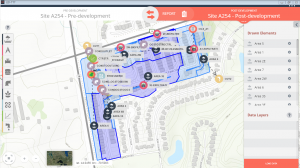Difference between revisions of "Low impact development treatment train tool"
Jenny Hill (talk | contribs) |
Jenny Hill (talk | contribs) m (Jenny Hill moved page Treatment train tool to Low impact development treatment train tool) |
||
| (12 intermediate revisions by 2 users not shown) | |||
| Line 1: | Line 1: | ||
| − | [[File:TTT_menu.PNG|thumb|x450 px| | + | [[File:LIDTTT.png|thumb|Screenshot of the LID TTT]] |
| − | + | [[File:TTT_menu.PNG|thumb|x450 px|Menu bar of the LID TTT]] | |
The Low Impact Development Treatment Train Tool (LID TTT) is designed to help developers, consultants, municipalities and landowners understand and implement more sustainable stormwater management planning and design practices in their watersheds. | The Low Impact Development Treatment Train Tool (LID TTT) is designed to help developers, consultants, municipalities and landowners understand and implement more sustainable stormwater management planning and design practices in their watersheds. | ||
| − | The | + | The LID TTT focuses on the use of Best Management Practices (BMP)’s and Low Impact Development (LID) techniques, and: |
*analyzes annual and event based runoff volumes, | *analyzes annual and event based runoff volumes, | ||
| − | **including water budget information: surface evapotranspiration, surface runoff, and infiltration to soil | + | **including water budget information: surface [[evapotranspiration]], surface runoff, and [[infiltration]] to soil |
| − | *provides estimates of | + | *provides estimates of [[water quality]] improvements. |
| − | The | + | The LID TTT is built upon the open source EPA SWMM5 model providing a user-friendly interface for novice modelers and cross-compatibility with SWMM5 for further model development. |
The LID TTT has been developed in partnership between [http://www.lsrca.on.ca/ Lake Simcoe Region Conservation Authority], [https://www.creditvalleyca.ca/ Credit Valley Conservation], and [https://trca.ca/ Toronto and Region Conservation Authority]. | The LID TTT has been developed in partnership between [http://www.lsrca.on.ca/ Lake Simcoe Region Conservation Authority], [https://www.creditvalleyca.ca/ Credit Valley Conservation], and [https://trca.ca/ Toronto and Region Conservation Authority]. | ||
| Line 19: | Line 19: | ||
*[[Rainwater harvesting: TTT|Rainwater harvesting]] | *[[Rainwater harvesting: TTT|Rainwater harvesting]] | ||
*[[Swales: TTT|Swales]] | *[[Swales: TTT|Swales]] | ||
| + | *[[Dry ponds: TTT|Dry ponds]] | ||
| + | *[[Pretreatment: TTT|OGS and filters]] | ||
| − | This links to the project page, where you can download your free copy of the TTT | + | This links to the project page, where you can download your free copy of the LID TTT. |
| − | {{Clickable button|[[File:TTT.png| | + | {{Clickable button|[[File:TTT.png|350 px|link=http://www.sustainabletechnologies.ca/wp/low-impact-development-treatment-train-tool/]]}} |
[[Category: Modeling]] | [[Category: Modeling]] | ||
Revision as of 20:07, 12 June 2018
The Low Impact Development Treatment Train Tool (LID TTT) is designed to help developers, consultants, municipalities and landowners understand and implement more sustainable stormwater management planning and design practices in their watersheds.
The LID TTT focuses on the use of Best Management Practices (BMP)’s and Low Impact Development (LID) techniques, and:
- analyzes annual and event based runoff volumes,
- including water budget information: surface evapotranspiration, surface runoff, and infiltration to soil
- provides estimates of water quality improvements.
The LID TTT is built upon the open source EPA SWMM5 model providing a user-friendly interface for novice modelers and cross-compatibility with SWMM5 for further model development.
The LID TTT has been developed in partnership between Lake Simcoe Region Conservation Authority, Credit Valley Conservation, and Toronto and Region Conservation Authority.
Integration with this guide is through suggested 'starting point' values for design parameters for the following BMP types:
- Bioretention
- Vegetated filter strips
- Infiltration trenches
- Permeable paving
- Rainwater harvesting
- Swales
- Dry ponds
- OGS and filters
This links to the project page, where you can download your free copy of the LID TTT.

